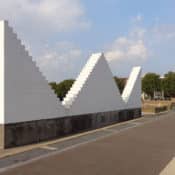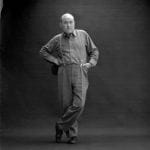With the Kabakovs, the collaboration probably worked well from the start, because it quickly bears remarkable fruits:
In 1989 Ilja Kabakov received a DAAD scholarship, Kabakov work will be exclusively in the DAAD galleries in Berlin this year, the DE Appel Foundation Amsterdam, the Institute of Contemporary Art and the Riverside Studios London, the University of the Saarland in Saarbrücken, the Genia Schreiber University Art gallery in Tel in Aviv and the Kunsthalle Zurich exhibited and invited to group exhibitions in Paris, Munich, Düsseldorf and five Japanese cities.
In 1992 they can already be seen on the documenta IX in Kassel and Ilja Kabakov teaches until 1993 at the Städelschule in Frankfurt am Main, in 1993 the Kabakovs represented their still more different home Russia 45th
This style continues: Working of the Kabakovs was shown in all important and many less well-known museum in the world, for the first time in Moscow (on private initiative by the American philanthropist George Soros) in 1998, in 2003/2004 officially at home, in the state-run pedjakow gallery Moscow and in the State Hermitage Museum in St. Petersburg.
The first Biennale was in Whitney in 1997, many followed, at the same time there were public orders from cities across Europe, the Kabakov are still extremely successful exhibition artists, whose art enriches a considerable number of exhibitions every year.

Photo by Garagemca [CC BY-SA 4.0]
Although the Kabakov team could only get started in the late middle of life, almost 300 solo exhibitions and a few hundred group exhibitions have come together to date; Kabakov works can always be seen somewhere-where they will be exhibited in the world (with a lead by 2020), interested parties can look up directly on Ilya-emilia-kabakov.com/exhibitions.
The artistic honors and awards are also piling up at the Kabakovs (although Ilja is mostly the honored, our individualist awards are usually not oriented towards real, fruitful cooperation between partners): 1990 Aachen Art Prize; 1992 Arthur Köpcke Award of the Köpcke Foundation Copenhagen; 1993 Max Beckmann Prize Frankfurt am Main, Josephbeutys Prize Basel, Honor Diploma Biennale of Venice; 1995 Chevalier de l'Ordre des Arts et des lettre, ministère de la culture paris; 1997 Best Show Award of the International Art Critic Association New York; 1998 Goslarer Kaiserring; 2000 Honor Doctor of the University of Bern; 2002 Oskar Kokoschka Prize, Federal Ministry of Education, Science and Culture Vienna; 2007 Honor Doctor of the University of Sorbonne Paris; 2008 Praemium Imperial ("Nobel Prize of Art") Japan Art Association, Order of Friendship by President of the Russian Federation, Honorary Medicine Moscow Art Academy; 2010 Cartier-Lifetime Achievement Award of the St. Moritz Art Masters; 2011 Innovation Prize Moscow, Louise Blouin Foundation Award New York; 2013 Medal for Life Nopy Events in Art, Moscow Art Academy; 2014 Commandur de l'Ordre des Arts et des Lettres, Ministery de la Culture Paris, Gold Medal for Achievements in Art, The National Art Club, New York; 2015 Award for Excellence in Arts, Appraisers Association of America New York.
For everyone who wants to enrich your vacation with mysterious art, here are the public collections that Kabakov works have ready:
- Australia : Queensland Art Gallery/Gallery of Modern Art Brisbane
- Belgium : Museum Voor Hedendaagse Art Antwerp, Stedelijk Museum Voor Actuele Art Gent
- Germany : Hamburger Kunsthalle Berlin, Kunsthalle Bremerhaven, K21 Düsseldorf, Museum of Modern Art Frankfurt am Main, Museum Ludwig Cologne, Gallery for Contemporary Art in Leipzig , Museum Wiesbaden
- Finland : Kiasma Museum of Contemporary Art Helsinki
- France : Musée Maillol Fondation Dina Vierny Paris
- Greece : National Museum of Contemporary Art Athens
- Great Britain : Tate Britain
- Italy : Museo Nazionale delle Arti del XXI Secolo + Nomas Foundation Rome, Centro per l'Arte Contemporanea Luigi Pecciitaly Prato
- Norway : The Museum of Contemporary Art Oslo
- Portugal : Ellipse Foundation Alcoitão
- Russia : Moscow Museum of Modern Art, National Center for Contemporary Arts Moscow, Tretjakov Gallery Moscow
- Switzerland : Basel's art museum
- Slovenia : Moderna Galerija Ljubljana
- Turkey : Huma Kabakcı Collection
- USA : Museum of Modern Art, Apexart, Exit Art New York City; Chinati Foundation Marfa, Texas
Farewell as a ticket to success
The work of art, which justified the fame of the freshly baked artist couple, was a farewell greeting to Moscow.
It is about the installation "The man who flew from his apartment to space", 1985, Moscow, bit.ly/2rfttdq. What comes along at first glance as a rubbed chamber with a hole in the ceiling, tells every fantasy woman the history of the Soviet Union; Together with all the privation that has suffered millions of Russians under the incompetent and therefore cruel rule: the room has exactly the dimensions of the one-room hole in which Ilja Kabakow had to live in Moscow.
The colorful posters on the walls are typical everyday Soviet propaganda, which tells in seemingly optimistic (and actually deeply depressing) representation of the joys of the Soviet life. The actual facility is not even optimistic, it is simply abysmally ugly shit, on the jump to the unpainted bed and the spin seat from belts and feathers unmoved and disorganized under, in the, over the rubble of the breakthrough ...
In the end, the fulfillment of the collective dream of all impressed is: the intoxicating vision of an escape, enables sudden, miraculously lent, overpowering power. The fact that this escape leads to space can be an expression of a deep human pessimism, but perhaps only a side blow to the Soviet part of the "race into space".
With all the irony, which is often in the cynicism, which can be found in Kabakov's work, perhaps also a violent blow against the collective of surprising Russian population; Kabakov should know exactly that improvement in the life of all people does not come by miracle, but is brought about by jointly acting people (the more people, the faster they come together, the more violent).
In any case, a "Kabakov", as is hardly typical, whereby the content of the respective installations touches a huge range of the adversity with which humanity has to deal with.
The closet with the crater in the roof was allowed to rise in New York for the exhibition "Ten Characters" in the Ronald Feldman Feldman Feldman Feldman: in Moscow, the original installation was only built by the hour because Kabakov had to fear uninvited state visits. In 1988 the installation was reconstructed and was able to show itself for the first time completely.
With the 9 characters, which (again, also the folding series "10 personaej" was created between 1972 and 1975) to the "man who flew from his apartment to space", the Kabakovs became pioneers of the overall installation. Each character fills a room with the demons of his life: the man who was so short that he wanted everyone else to take care of him; the talentless artist who received many official orders; The tenant who never thrown away anything ...
Because it would be almost nasty to show the discovery of the much too unknown art of the Kabakovs, only a few titles can stimulate the appetite here:
- "Vškafusidjaščij Primakov" , 1972 (The Cabinet Seater Primakov; a long, in memory of the forefather of the Russian avant -garde Kasimir Malewitsch, completely black narrative in several files)
- "BY December 25 in our District ..." , 1983 (the two buildings are supposed to build the long list of schools and hospitals by the end of 1979, but did not even start on December 25th four years later)
- "Vacation No. 1-8" , 1987 (long vacation, for Soviet citizens from life, before even one of the benefits promised by the government is realized)))
- "Incident in the hallway near the kitchen", 1989.
- "The Red Wagon" , 1991 (History of the Soviet Union in a quick run, ends in a pile of rubble)
- "The Man Climbing Over The Wall" , model for the sculpture "The Eternal Emigrant", 1995/2004
- "The fallen chandelier" , 1996 (according to Kabakov, the actual work of art is the reaction of passers -by))
- "Model for Healing with Paintings" , 1996/2010 (in 2010 was there a effect?)
- "How to Meet an Angel #2", 1997/2014
- "And you look up and read the words" , 1997 (sculpture with text, see www.orbit.zkm.de/?q=node/20 )
- "Wordless" , 1999 (relationship work on/in the river)
- "Not everyone will be taken to the future" , 2001 (and exhibition title: "Not Everyone wants to be taken into the future", November 18, 2017 - January 28, 2018 in Tate Modern London)
- "Palace of Projects" , 2001 (in the Salzlager of the Zollverein Kokerei: Bit.ly/2BHVJKV )
- "The Window Into My Past", 2012
- "20 Ways to get to Apple Listening to the Music of Mozart", 2016
What remains: much more than ironic art or a piece of Russia in New York.


















